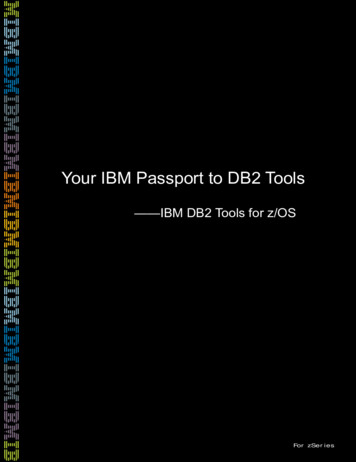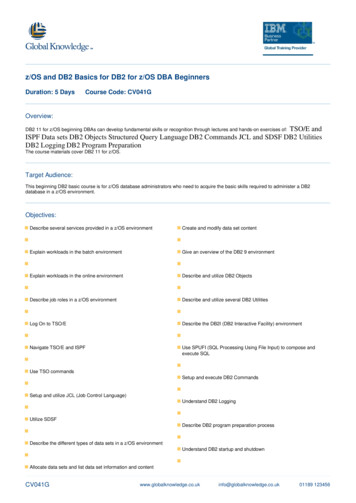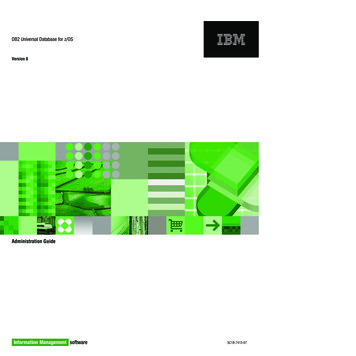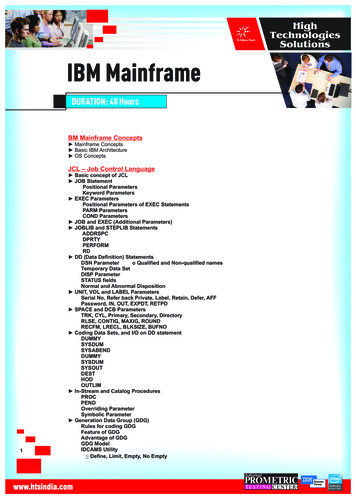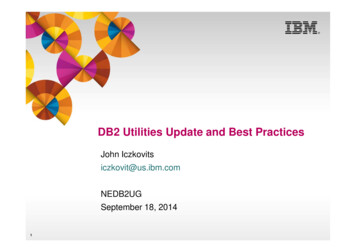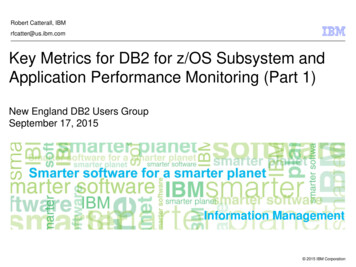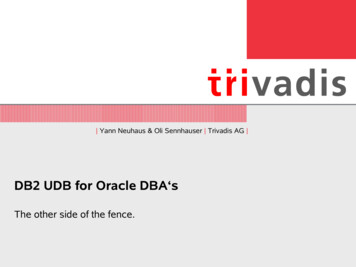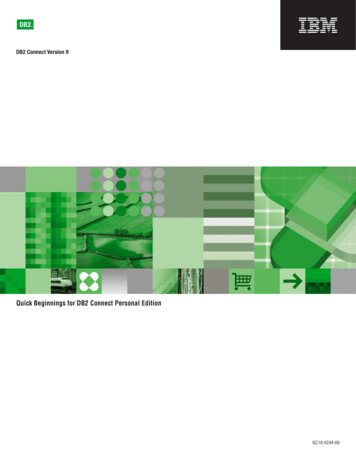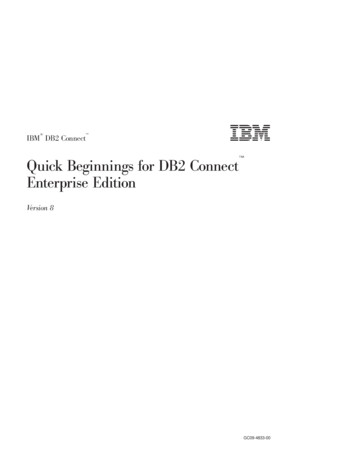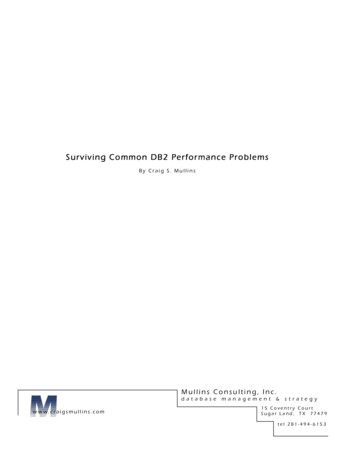
Transcription
Su rv iv ing C o mmo n D B2 Pe rfo r ma n ce P ro b l em sBy Craig S. MullinsMullins Consulting, Inc.databasewww.craigsmullins.commanagement &strategy15 Coventry CourtSugar Land, TX 77479tel 281-494-6153
A Mullins Consulting, Inc. white paper written for:Quest Software, Inc.8001 Irvine Center DriveIrvine, CA 92618Telephone: 949 754 8000 Fax: 949 754 8999www.quest.comPublished by:Mullins Consulting, Inc.15 Coventry CourtSugar Land, TX 77479Telephone: 281 494 6153 Fax: 281 491 0637www.CraigSMullins.comJune 2005All rights reserved. No part of this report may be reproduced or stored in a retrieval systemor transmitted in any form or by any means, without prior written permission. 2005, Mullins Consulting, Inc.Page 2
Su rv iv ing C o mmo n D B2 Pe rfo r ma n ce P ro b l em sIn today’s modern enterprise, information is power; and database systems are thepredominant technology for storing, managing, and accessing the data that enterprisesuse to turn into information. And DB2 is one of the leading database systems on themarket.DB2 is used by 100 percent of Fortune 100 firms and 80 percent of the Fortune 500. Assuch, it is an important component of the applications that drive the most significantbusinesses in the world.Dynamic businessrequirements forceconstant change andoverwhelming complexityon the typical ITenvironment.Dynamic business requirements force constantchange and overwhelming complexity on the typicalIT environment. Regulatory compliance issues, timeto-market pressures, and industry consolidationscause turbulence as IT struggles to keep systems insync with business demands. But managing systemsbecomes even more troublesome as technologytrends evolve. Examples of these trends includebusiness intelligence, e-commerce, and rapidsoftware versioning.And data growth continues unabated. Indeed, Winter Corp., a research and consultingfirm, publishes a semi-annual survey of the largest and most heavily used databases inthe world. The most recent Winter report, published in 2003, confirms this explosion ofdata with the average size of an OLTP database growing from 1 TB in 2001 to 4.4 TB in2003. Grappling with performance problems in this rapidly changing – and growing –environment is complicated, at best.At the same time, the mainframe workforce is aging and retiring. As the number ofmainframe professionals with years of experience decrease, they must be replaced withyounger technicians – and these technicians require a different interface than the greenscreen, ISPF interface that is still the most common mainframe interface.These trends drive home the need for DBAs to exertconstant vigilance over the performance andavailability of their DB2 environment. Anyperformance slip can impact the business resulting inlost revenue or damaged customer relationships.Furthermore, it is important to be able to achievethis performance management capability with amodern, easy-to-use interface. Enterprises cannotreap the full range of benefits from their databasesystems without modern, effective performancemonitoring and management capabilities.Enterprises cannot reapthe full range of benefitsfrom their databasesystems without modern,effective performancemonitoring andmanagement capabilities.The answer is to equip the DBA staff with solutions that can simplify and automate theperformance management process in a cost effective manner. There are many powerful,DB2 performance monitoring tools available, but many of them are difficult to use. Asthe mainframe skills gap continues to widen, products with a flexible, graphical userinterface make analyzing mainframe performance easier.1According to the Mainframe Report 2005 from Arcati, Ltd. “when a (mainframe) personleaves, it is not simple technical knowledge they take with them but rather twenty years’intimate and detailed understanding of core business applications.” Most legacyperformance tuning products are character-based and difficult to master. Productsdeploying a GUI will be better-suited for the future workforce.1The Arcati Mainframe Yearbook 2005, “The Mainframe: Forty Years On”, page 7 2005, Mullins Consulting, Inc.Page 3
DB2 Performance: At Fifty Thousand FeetTo help meet these challenges, DBAs must possess the necessary tools to automate themaintenance and performance management of their DB2 environment. But what do wereally mean by DB2 performance?Let’s start by thinking about this question at a high level – a 50,000 foot level, if youwill. Every DB2 application requires three components to operate: the system, thedatabase and the application itself. The system refers to the DB2 subsystem installationand its interfaces to other system software (e.g. z/OS or CICS). The database refers tothe database objects that house the application data. And the application is the hostlanguage code and SQL that provides each program’s functionality. To effectively deliverDB2 performance, the DBA must be able to monitor and tune each of these components.Let’s take a look at some of the most common problems that DBAs encounter whenmanaging each of these components.DB2 Subsystem PerformanceSuccessfully managing DB2 performance begins with the DB2 subsystem. In order todeliver consistent system performance, the DBA must have the resources to monitor,manage and optimize the resources used by DB2.Tasks required for system tuning include the proper allocation and management ofmemory structures (e.g., buffer pools, EDM pool, etc.), storage management, integrationof the DBMS with other system software, proper usage of database logs, andcoordination of the operating system resources used by the DBMS. Additionally, the DBAmust control the installation, configuration and migration of the DBMS software. If thesystem isn't performing properly, everything that uses the system will perform poorly. Inother words, a poorly performing system impacts every database application.The more efficientlymemory is allocated the better DB2 willperform.Efficient usage of memory is one of the biggeststruggles for DB2 performance tuners. Relationaldatabase systems love memory and DB2 usesmemory for buffer pools, the EDM pool, the RIDpool and sort pools. The more efficiently memory isallocated to these structures, the better DB2 willperform.DB2 provides 80 different buffer pools that can be configured to cache data in memoryfor DB2 programs to access. Forget about trying to follow a cookie-cutter approach tobuffer pool management. There is no simple formula to follow that will result in anoptimally buffered system that works for every implementation. Each shop must createand optimize a buffer pool strategy for its own data and application mix.The trick is to know how to tune your buffer pools so that they match your workload. Ofcourse, you also have to ensure that you do not exceed the memory allocation for youroperating system and platform, or system paging will occur and performance will suffer.To configure your buffer pool based on workload, you need to know how your databaseobjects are accessed. There are basically two types of access: sequential and random. Anaccess request is sequential if it starts by reading one record and continues reading thenext records in sequence; this may or may not reflect the way the data is actually storedon disk. Random access, on the other hand, is typified by requests that access a singlerecord based on a key.If you have database objects that are accessed primarily sequentially, you can takeadvantage of this knowledge by assigning them to a buffer pool that is configured forsequential access. This is accomplished by setting that buffer pool’s sequential stealthreshold (VPSEQT), the parallel sequential steal threshold (VPPSEQT), and the assistingparallel sequential steal threshold (VPXPSEQT) to indicate that access is mostlysequential. 2005, Mullins Consulting, Inc.Page 4
VPSEQT specifies thepercentage of thebuffer pool that shouldfavor sequentialprocessing.These thresholds dictate to DB2 how much of the bufferpool should be set for sequential processes. Considerthe VPSEQT parameter, for example: it specifies thepercentage of the buffer pool that should favorsequential processing. For example, by setting VPSEQTto 95, DB2 will favor stealing a random page over asequential page until 95 percent of the buffer pool isfilled with sequential pages. VPPSEQT and VPXPSEQTare specified as percentages of VPSEQT and are used tospecify the sequential steal threshold for paralleloperations.Of course, to successfully configure your buffer pools you will need to be able todetermine how your database objects are being accessed: sequentially or randomly.Furthermore, you will need to have a method of monitoring the performance of thosebuffer pools once configured. Each buffer pool has additional thresholds associated withit that provide usage and control information about buffer pool operations.You will want to monitor the prefetch disabled threshold, especially for buffer pools thatare tuned for sequential access. This threshold kicks in when 90 percent of the bufferpool pages are unavailable. When this threshold is reached, DB2 no longer initiatesprefetch operations and will cancel prefetch operations in progress.Additionally, you will need to watch for the data manager critical threshold. It isreached when 95 percent of the buffer pool pages are unavailable. At this point DB2 willaccess pages once for each row that is retrieved or updated in that page. This should beavoided at all times. Basically, when you hit this threshold and you retrieve or updatemore than one row on the same page, DB2 will invoke a separate page-access operationfor each access. And that will cause severe performance degradation.Finally, you will need to monitor the immediate write threshold. When 97.5 percent ofthe buffer pool pages are unavailable, DB2 writes updated pages as soon as the updateis complete. In other words, writes are performed synchronously instead ofasynchronously. This causes an increase in the number of write I/Os performed by DB2.If any of the last three thresholds are reached there are only two methods of makingchanges to alleviate the problem: either increase the size of the buffer pool or reallocatethe database objects to other buffer pools. But remember, larger buffer pool sizes arenot always more efficient. DB2 is not the only consumer of memory in your system, sotake care when allocating buffer pool memory.A good buffer pool monitoring technique is to monitor the buffer pool hit ratio for eachof your buffer pools. The hit ratio can be calculated as follows:((GETPAGES – SUM OF ALL PAGES READ) / GETPAGES ) * 100The “sum of all pages read” must account for synchronous and asynchronous I/O. Thisratio basically tells you the percentage of times that a requested page was available inmemory. When a page is available in memory DB2 does not have to read the page fromdisk and performance improves. The larger the hit ratio number, the better.Up to this point we have been more worried about reading data, than writing it. Butthere are thresholds that need to be tuned that control how modified data is writtenfrom the buffer pools back to disk. These are the deferred write thresholds (DWQT andVDWQT).DWQT is set as a percentage of the buffer pool that can be occupied by updated pagesand in-use pages. The default value is 50 percent, but this is usually too high for mostsites. When the percentage of unavailable pages exceeds the threshold, asynchronouswrites are scheduled for the updated pages. VDWQT is similar to DWQT, but for a singledata set; its default is 10 percent (and that is likely to be too high as well). 2005, Mullins Consulting, Inc.Page 5
By lowering your deferred write thresholds your DB2 subsystem will have regularasynchronous writes of updated pages to disk. Pages that are frequently referenced willremain in the buffer pool even if updates are written out to disk.But never set VDWQT higher than DWQT; doing so would have no effect because thepages for each data set also apply to the overall percentage.Visually monitoring and managingthresholds and hit ratios aids in DB2performance tuning.Another consumer of memory in your DB2subsystem is the EDM Pool, which is used forcaching internal structures used by DB2programs. This includes DBDs, SKCTs, CTs,SKPTs, and PTs. It also includes theauthorization cache for plans and packages,as well as the cache for dynamic SQL miniplans. DB2 V8 splits the EDM pool intoseparate pools for each of these structures.As a general rule, you should shoot for an80 percent hit rate for EDM pool objects.Another way of stating this is that only oneout of every five times a structure is requiredshould it need to be loaded into memory.It is important to monitor EDM Pool usage because an EDM Pool failure can bring DB2 toa screeching halt. If there is no place to cache the structures needed for a new iterationof a program to run, then that program will wait. And so will the user trying to run theprogram.Of course, memory allocation is not the only component of DB2 subsystem tuning. Youwill also need to be able to view information about locking to resolve lock timeout anddeadlock situations, as well as to be able to configure the locking system parameters(DSNZPARMs) appropriately. Actually, having a method to quickly and easily view theDSNZPARM settings for your DB2 subsystem is a necessity – especially for those timeswhen you are in the middle of resolving a difficult problem.Determining the cause of locking problems can beparticularly troubling. When wait time is excessive,performance will degrade. A vigilant DBA must becapable of tracing the lock list to determine if it isproperly sized, checking the average time thatapplications are waiting (and why), and figuring outhow many locks are allocated for a database.Determining thecause of lockingproblems can beparticularly troubling.Keep in mind, too, that this is a high-level paper on DB2 performance management andthat there are many more components required to achieve proper DB2 systemperformance. Other system elements requiring attention include allied agent (CICS, TSO,etc.) tuning, monitoring disk I/O, tuning logging, and Parallel Sysplex configuration andmanagement for DB2 data-sharing shops.Keeping an eye on so many performance monitoring and tuning details can be anoverwhelming task without a tool that can gather and visually represent the diagnosticinformation in an organized fashion.DB2 Database Objects and PerformanceAlthough many factors contribute to poor database performance, it is particularimportant to pay attention to your database objects. The term database objects refers tothe table spaces, tables, and indexes that comprise your DB2 databases.Of course, the first factor for ensuring efficient database objects is practicing properdatabase design. This means starting from a fully normalized logical data model. Thedata model should be used as a template for building your physical DB2 database,deviating from the model only for performance reasons. 2005, Mullins Consulting, Inc.Page 6
After implementing aneffective physical DB2database, the next step is toensure that you are capturingstatistics appropriately forthe database objects.After implementing an effective physical DB2 database,the next step is to ensure that you are capturingstatistics appropriately for the database objects. Theuse of inaccurate or outdated database statistics bythe DB2 query optimizer often results in a poor choiceof query execution plans and hence unacceptably longquery processing times.Inaccurate statistics are a leading cause of inefficiencies in DB2 applications. Indeed,during a presentation at a recent IDUG conference (2004) a presenter from IBM’s SiliconValley Lab indicated that as many as half of all access path “problems” presented toIBM’s technical support were caused by inaccurate, outdated, or missing statistics.Statistics are accumulated by the RUNSTATS utility. You should schedule a regularexecution of RUNSTATS for all dynamic database objects. If the data grows or changeson a regular basis, you need to plan and run the RUNSTATS utility accordingly. Only byhaving up-to-date statistics can the DB2 optimizer have the correct information togenerate accurate access paths for your SQL queries.RUNSTATS also gathers additional information about the current state of each object.This state, or organization data, is used by the DBA to determine when an object needsto be reorganized. Table spaces and indexes become disorganized as business users runapplication programs that insert, update, and delete data in DB2 tables – causing theonce-ordered data to become fragmented. Disorganized data can be particularlydetrimental to the performance of your DB2 systems. To understand how disorganizationimpacts performance, let’s review the concept of clustering.Each DB2 table can have a single clustering sequence defined for it. This is accomplishedwith a clustering index. When clustering is defined, DB2 attempts to maintain thesequence of the rows in the physical order in the table space.But as data is inserted and modified and pages fill up, there may not be sufficient spaceavailable to insert the data in the proper sequence. So the data is inserted where spaceexists and clustering begins to break down. As the data becomes unclusted, theperformance of sequentially accessing data in clustering order begins to degradebecause more I/O operations are required to retrieve the data. Running a reorganizationwill re-cluster the data, and thereby improve performance.Of course, clustering is not the only organization detail that can impact performance.You must also keep an eye on other details such as: The percentage of each table space containing data from tables that have beendropped. As this percentage increases, performance gets worse. The leaf distance for indexes, which indicates the average number of pages betweensuccessive index leaf pages. Performance degrades as the leaf distance increases. Far-off and near-off pages for indexes, which estimates how many of the rows in thetable are inefficiently located. As the number of far- and near-off rows increases,performance gets worse. Near and far indirect references for a table space, which indicate the number ofrows that have been relocated either near (2 to 15 pages) or far away (16 or morepages) from their original location. This relocation can occur as the result ofupdates to variable length rows. As the number of near and far indirect referencesincreases, performance gets worse.All of these factors impact on the efficiency of yourdatabase objects. Failing to monitor and correctorganization problems will cause every applicationaccessing these objects to suffer performancedegradation. The wise course of action is to monitorthese statistics. Set thresholds for each that cause aREORG to be scheduled when the threshold value isreached. For example, monitor the cluster ratio andwhen it falls below 90 percent schedule a REORG. 2005, Mullins Consulting, Inc.Failing to monitor andcorrect organizationproblems will cause performancedegradation.Page 7
Creating the appropriate indexes for your DB2 tables and applications is a discipline thatspans database and application tuning. To create appropriate indexes, the DBA musthave the SQL that is to be used against the DB2 objects in order to understand theaccess patterns. Furthermore, an understanding of the workload that is being runagainst your system is needed. This information enables you to balance index creationand buffer pool placement so that your setup matches what is being run against it.Usually, though, DBAs tend to create indexes before having knowledge of the SQL thatwill be running against their tables. Some indexes are required regardless of the SQLbeing run, for example to support a primary key or unique constraint, or to enhance theperformance of referential constraints. But the vast majority of your indexes should be tosupport SQL in your application code.Of course, there are more severedatabase performance problems that youcan encounter. For example, considerthe impact to your applications ofrunning out of space. When a tablespace runs out of space and has no moreroom to expand or extend, any attemptto add more data will fail. And a failureis the worst kind of performanceproblem – an availability problem.The best approach to managing theperformance of your DB2 databaseobjects is to use a tool that can helpyou to automate the setup andmonitoring of space and organizationthresholds. If you fail to take thisapproach, you are probably eitherwasting CPU cycles by reorganizingbefore it is required; or you areincurring performance problemsbecause you are not reorganizinguntil well after it is required.Space management issues can severely impactDB2 performance.A dynamic, automated toolset can help you to reorganize at just the right time andthereby optimize your resource usage and your DB2 systems and to predict outages andproblems so you can resolve the issues before the problems happen.DB2 Application PerformanceThe third component of DB2 performance is the application itself. As much as 80 percentof all relational database performance problems can be tracked back to inefficientapplication code. The application code consists of two parts: the SQL code and the hostlanguage code in which the SQL is embedded.Although SQL is simple to learn and relatively easy to learn at its most basic level, it isactually quite difficult to master. There are, of course, some general rules of thumb youcan apply to help you to build efficient SQL statements. Keep in mind though, that a ruleof thumb is helpful as a general guideline, but it is not to be applied in every situation.The first major rule of thumb for SQL programming is to build the SQL to do the workinstead of the application program. By this I mean that you should code the properWHERE clauses in your SQL instead of waiting to filter data in your host program.Additionally, do not treat DB2 tables like master files. Code SQL joins instead of multiplecursors where a “master” cursor is read that then drives the other cursors. SQL is a setprocessing language and it should be coded that way.Another common problem is retrieving more data than is required. Your SQL statementsshould retrieve only the columns required, never more. Each column that has to beaccessed and returned to you program adds overhead that can be avoided if the columnis unnecessary. Sometimes programmers try to use the SELECT * shortcut – and though 2005, Mullins Consulting, Inc.Page 8
that may be fine for quick and dirty testing, it should never be allowed in productionprograms.It is also important to understand the different types of predicates and their impact onperformance. Stage 1 predicates are better than Stage 2; and indexable predicates arebetter than non-indexable.A predicate that can be satisfied by the Data Manager portion of DB2 is referred to asStage 1. A Stage 2 predicate has to be passed from the Data Manager to the RelationalData System to be satisfied. The Data Manager component of DB2 is at a level closer tothe data than the Relational Data System. The earlier in the process that DB2 canevaluate the predicate, the more efficient processing will be. So, Stage 1 predicates aremore efficient than Stage 2.Additionally, a query that can use an index has more access path options, so it can bemore efficient than a query that cannot use an index. The DB2 optimizer can use anindex or indexes in a variety of ways to speed the retrieval of data from DB2 tables. Forthis reason, try to use indexable predicates rather than those that are not.At this point you are probably asking something like “which predicates are Stage 1 andwhich are indexable?” Where predicates are processed can change from version toversion of DB2. This information is documented in the IBM DB2 Database AdministrationGuide manual, which can be downloaded from the IBM web site free-of-charge.Another technique for improving performance is to create indexes to support yourORDER BY and GROUP BY clauses. If an index is available on the columns you specify tothese clauses, DB2 can use the index to avoid invoking a sort. And that is likely toimprove the performance of your SQL statement.After the SQL is coded, to ensure proper performance you can review and interpretaccess path information collected using the EXPLAIN command. The EXPLAIN commandcan be executed on a single SQL statement or multiple statements in an entire program.EXPLAIN captures information about the access paths chosen by the DB2 optimizer andpopulates it into a special table called a PLAN TABLE. The PLAN TABLE contents areencoded and a DBA or analyst must interpret that data in order to determine exactlywhat DB2 is doing.To effectively tune SQL though, you will require additional performance metrics than justwhat is in the PLAN TABLE. Based on execution circumstances DB2 may have to reevaluate an access path at run time: for example, to avoid using RIDs in the event of aRID pool failure or if there is a lack of storage for a list prefetch operation.SQL performance tuningrequires an ability tointerpret the contents ofthe PLAN TABLE inconjunction with the SQLcode, host language codeand information from theDB2 catalog SQL performance tuning requires an ability to interpretthe contents of the PLAN TABLE in conjunction withthe SQL code, host language code and informationfrom the DB2 catalog to judge the efficiency andeffectiveness of each SQL statement. Analysis of theaccess path information and additional performancemetrics can require a tuner to make SQL modifications.Perhaps you will need to modify predicates toinfluence indexed access, or perhaps revise astatement to use Stage 1 instead of Stage 2 predicates.An in-depth analysis of your SQL statement can lead to the determination that indexchanges or additional indexes will be required. So, you see, application tuning can leadback to database object tuning. And index tuning can be tricky; changing an index toimprove the performance of one query can degrade the performance of other queries.Build indexes on the predicates of your most heavily-executed and most importantqueries. Do not arbitrarily limit the number of indexes per table. Create as many as arenecessary to improve query performance. But remember to balance that against yourdata modification needs. An index can improve query performance, but it will degradethe performance of data modification because the index has to be modified when itsunderlying data is inserted, deleted, or updated. 2005, Mullins Consulting, Inc.Page 9
You might also consider overloading indexes by adding columns to encourage index onlyaccess. For example, if you have a query that is frequently run throughout the day and itaccesses five columns, four of which are in an index, adding the fifth column to thatindex allows DB2 to get all of the data from the index alone. Avoiding I/O to the tablespace can help to improve performance.Finally, remember that efficient SQL coding and proper indexing are not the onlyreasons for poor application performance. An inefficiently designed host languageprogram can cause poor performance, too. Host language code is the code written in aprogramming language such as Java, COBOL, C, or your programming language ofchoice. SQL statements are embedded into the host language code and it is possible tohave a well-tuned SQL statement embedded into an inefficient application program.Once again, to effectively manage the performance of your DB2 applications requiresflexible and easy-to-use tools. It is important that you are able quickly to find theprograms that are consuming the most resources. You do not want to have to wadethrough pages and pages of performance reports to find the offending programs; neitherdo you want to have to navigate through screen after screen of options and confusingmenus.The best option is to use a tool that works as a tuning lab for your SQL. You will needthe ability to find the offensive SQL and then be able to play “what if” scenarios bymodifying the SQL and gauging the performance impact of each change. It is even betterif the tool can provide expert tuning advice to guide you as you change your SQLstatements.The Complexity of DB2 PerformanceWe have discussed a number of the most common DB2 performance-related issues andproblems in this paper. After digesting this information, it should be apparent to youthat DB2 performance management is quite complex. Mastering all of the nuancescovered in this paper is difficult – and remember, these are just the most commonproblems. Much more needs to be mastered to ensure efficient DB2 performance.As the dynamics of the workforce change andnew releases of DB2 add features andcomplexity, the problem is exacerbated. Thebottom line is that software tools that automatethe detection and correction of DB2 performanceproblems helps to simplify DB2 performancemanagement. software tools thatautomate the detectionand correction of DB2performance problems helpto simplify DB2performance management.Furthermore, database performance tools need to be designed to be easy to use, yethighly functional. As skilled mainframe professionals retire, they will be replaced withyounger technicians who have not had the same level of exposure to mainframe systems.These younger technicians will expect to use tools with graphical interfaces, pull-downmenus, and point-and-click functionality. Of what possible use is a complex tool withbroad functionality that no one can figure out how to use?SummaryTo succeed in your DB2 performance management objectives you must be able tomonitor and tune all three major components of your DB2 environment: the DB2subsystem, the database objects, and your DB2 applications.A wise organization will be prepared to adapt to the changing workforce and the relatedcomplexities being driven into today’s IT env
DB2 performance monitoring tools available, but many of them are difficult to use. As the mainframe skills gap continues to widen, products with a flexible, graphical user interface make analyzing mainframe performance easier. According to the Mainframe Report 2005 from Arcati, Ltd.1 "when a (mainframe) person
